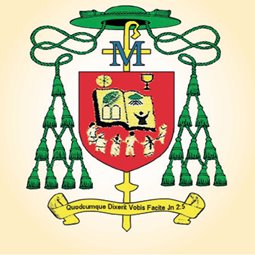c. The Tree: Symbol of the Cross of Lord Jesus Christ from which springs forth the seven sacraments.
d. The ORANTE: (a person with hands raised above) symbolizes the Church at prayer.
The Liturgical Symbols of the Christian Passover: The shield contains the three elements on which the Christian life is based, namely: The Liturgy (Bread Broken & Cup of Chalice), The Word and The Community.
The Christian Family: The Domestic church, the basic unit of the Christian community, receives its life from the cross; and it is nourished by the Word, the Sacraments and the Teaching of the Church.

